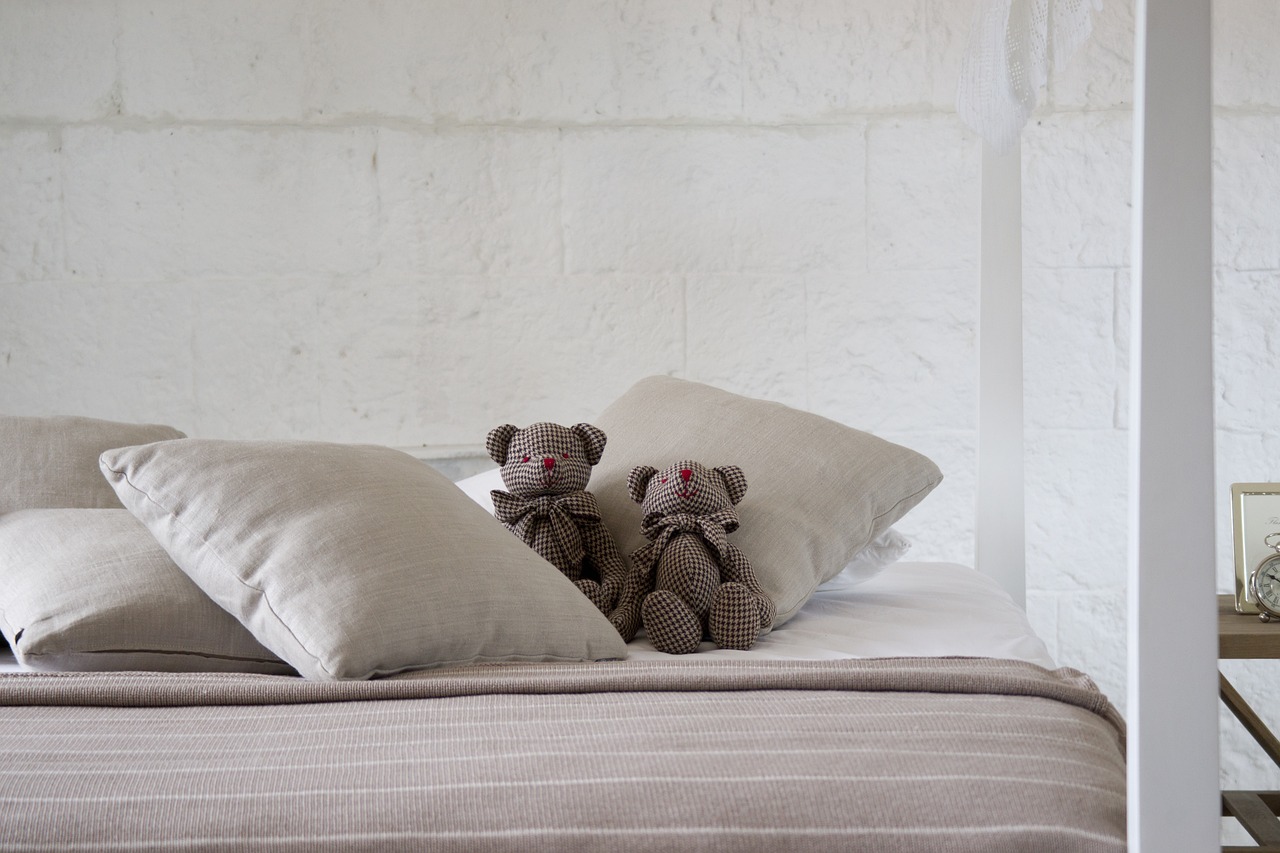How to Maintain a Quilting Rhythm
Quilting is more than just a hobby; it's a form of art that requires not only skill but also a certain rhythm to truly flourish. Just like a musician finds their tempo, quilters must discover their own unique flow to create beautiful pieces. Maintaining a consistent quilting rhythm is essential for ensuring that your projects progress smoothly and that you enjoy every moment spent stitching. In this article, we’ll explore effective strategies and tips that will help you keep your quilting momentum going, so you can turn fabric into masterpieces without feeling overwhelmed.
Before diving into the world of quilting, it's crucial to understand the various stages involved in the process. Each phase, from planning and cutting to sewing and finishing, plays a vital role in achieving a seamless rhythm. Think of it as a dance; each step must be performed in harmony with the others. By gaining insight into the quilting process, you can identify key stages that contribute to a smooth workflow. For instance, planning your design and color palette beforehand can save you time and prevent any last-minute decisions that might disrupt your rhythm. This way, you can focus on the joy of creating rather than scrambling to find the right materials.
Creating a dedicated quilting space is like setting the stage for your performance. A well-organized and inviting area can significantly enhance your productivity and focus, allowing you to immerse yourself in your projects without distractions. Imagine walking into a space where everything is in its place, and the air is filled with the scent of fresh fabric. It’s inspiring! To achieve this, consider the layout of your workspace. Make sure your sewing machine is easily accessible, and arrange your materials in a way that feels intuitive. This setup not only boosts your efficiency but also makes the whole quilting experience more enjoyable.
Proper organization of fabrics, tools, and supplies is crucial for saving time and fostering a more enjoyable quilting experience. Picture this: you’re in the zone, sewing away, and suddenly you realize you can’t find that perfect shade of blue fabric you were using. Frustrating, right? By keeping everything within reach and easy to access, you can maintain your rhythm without unnecessary interruptions. Consider using clear bins for your fabrics, so you can see at a glance what you have. Additionally, a pegboard for tools can keep your workspace tidy and your essentials within arm's reach.
Implementing effective storage solutions can help maintain an organized workspace. Here are a few ideas:
- Fabric Bins: Use labeled bins to categorize your fabric by color or type.
- Tool Caddies: Keep your scissors, rotary cutters, and other tools in a portable caddy.
- Rolling Carts: A rolling cart can be incredibly handy for moving supplies around as needed.
By ensuring that your materials are neatly arranged and easily retrievable, you can spend less time searching and more time creating.
Using labeling techniques for your fabrics and supplies can streamline your workflow. Consider labeling your bins and shelves so that you can quickly find what you need. This not only reduces the time spent searching but also creates a visually pleasing environment. A well-organized space can inspire creativity and keep your quilting rhythm intact.
Developing a consistent quilting routine is akin to establishing a workout regimen. Just as athletes train regularly to build endurance, quilters benefit from setting aside dedicated time for their craft. By creating a schedule that works for you, you can build momentum and maintain focus. Whether it’s an hour each evening or a few hours on the weekend, having a routine helps you progress through your projects without feeling overwhelmed. Plus, it gives you something to look forward to—like a mini retreat into your creative world!
Taking regular breaks during quilting sessions is essential for maintaining creativity and preventing fatigue. Think of it this way: even the most skilled musicians take a moment to pause and breathe. When you give yourself permission to step away, you allow your mind to recharge and your creativity to flourish. This can lead to fresh ideas and renewed enthusiasm when you return to your project.
Being mindful of your physical well-being while quilting can help you recognize when it's time to take a break. If you start feeling fatigued or notice tension in your shoulders, it’s a sign to step back. Consider incorporating stretches or even a quick walk to refresh your mind and body. Remember, quilting is meant to be enjoyable, not a chore!
Finding ways to stay inspired, whether through new patterns, techniques, or community engagement, can rejuvenate your quilting rhythm. Join local quilting groups or online forums where you can share your work and get feedback. You might discover exciting new ideas or techniques that reignite your passion for quilting. After all, inspiration can strike from the most unexpected places!
Q1: How can I improve my quilting speed without sacrificing quality?
A1: Practice makes perfect! The more you quilt, the faster and more efficient you'll become. Consider setting small, achievable goals for each session.
Q2: What should I do if I feel stuck on a project?
A2: Take a break! Sometimes stepping away for a bit can provide the clarity you need. You might also try working on a smaller project to reignite your creativity.
Q3: How can I find new quilting patterns?
A3: Explore quilting blogs, Pinterest, or local quilting shops for inspiration. Joining a quilting community can also expose you to fresh ideas and patterns.

Understanding the Quilting Process
This article explores effective strategies and tips for maintaining a consistent quilting rhythm, ensuring that your projects flow smoothly and enjoyably from start to finish.
Gaining insight into the quilting process is crucial for any quilter aiming to achieve a seamless rhythm in their work. Think of quilting as a beautiful dance, where each step—from planning to finishing—plays a vital role in creating a harmonious masterpiece. The process can be broken down into several key stages:
- Planning: Before diving into your fabric stash, take some time to visualize your project. Sketching your design or even jotting down notes can help clarify your vision, making the subsequent steps much smoother.
- Cutting: Precision is key here. Accurately cutting your fabrics not only ensures that the pieces fit together perfectly but also saves you from frustration down the line. Use a rotary cutter and mat for the best results.
- Sewing: This is where the magic happens! As you stitch your pieces together, keep your sewing machine in top shape with regular maintenance. A well-oiled machine can make all the difference in your quilting rhythm.
- Finishing: Don't underestimate the power of a good finish. Whether it’s binding your quilt or adding a label, these final touches can elevate your project from good to great.
Each of these stages contributes to your overall quilting experience, and understanding them allows you to identify where you might be losing your rhythm. For instance, if you find yourself spending too much time in the cutting phase, consider investing in better tools or techniques to streamline the process.
Moreover, it's essential to remember that quilting is not just about the end product; it's about enjoying the journey. Embrace the mistakes and the learning curves, as they often lead to the most rewarding experiences. Just like a musician practices their scales, a quilter must practice their skills, which can lead to a natural flow in their quilting rhythm.
Creating a dedicated quilting space can significantly enhance your productivity and focus, allowing you to immerse yourself in your projects without distractions.
Proper organization of fabrics, tools, and supplies not only saves time but also fosters a more enjoyable quilting experience, keeping everything within reach and easy to access.
Implementing effective storage solutions can help maintain an organized workspace, ensuring that your materials are neatly arranged and easily retrievable whenever you need them.
Using labeling techniques for your fabrics and supplies can streamline your workflow, making it easier to find what you need and reducing time spent searching.
Developing a consistent quilting routine can help you build momentum and maintain focus, making it easier to progress through your projects without feeling overwhelmed.
Taking regular breaks during quilting sessions is essential for maintaining creativity and preventing fatigue, ensuring that you stay engaged and inspired throughout the process.
Being mindful of your physical well-being while quilting can help you recognize when it's time to take a break, promoting a healthier and more sustainable quilting practice.
Finding ways to stay inspired, whether through new patterns, techniques, or community engagement, can rejuvenate your quilting rhythm and keep your passion alive.
Q: How can I improve my quilting speed?
A: Focus on organizing your space and materials, establish a routine, and practice your cutting and sewing techniques. The more you quilt, the faster you'll become!
Q: What should I do if I feel stuck or uninspired?
A: Take a break, explore new patterns, or engage with the quilting community for fresh ideas. Sometimes a little distance can reignite your passion.
Q: How often should I clean my sewing machine?
A: It's best to clean your sewing machine after every few projects or whenever you notice lint buildup. Regular maintenance keeps your machine running smoothly.

Setting Up a Dedicated Space
Creating a dedicated quilting space is like setting the stage for a grand performance; it’s where your creativity can truly shine without the chaos of everyday life intruding. Imagine walking into a room that feels like your personal sanctuary, filled with vibrant fabrics and the soothing hum of your sewing machine. This is not just about having a corner in your home; it’s about cultivating an environment that inspires you to dive into your quilting projects with enthusiasm and focus. A well-organized space can significantly enhance your productivity, allowing you to immerse yourself fully in the art of quilting.
When setting up your quilting area, consider the layout and functionality. You want to ensure that your workspace is both comfortable and efficient. Think about the flow of your work. For instance, position your cutting table near your sewing machine to minimize the distance you have to move materials. This simple change can save you time and keep your momentum going. Additionally, good lighting is essential; natural light is ideal, but if that’s not possible, invest in bright, adjustable lamps that can illuminate your workspace without straining your eyes.
Moreover, keep in mind the importance of ergonomics. Quilting can be taxing on your body, especially your back and neck, so choose a chair that offers proper support. You might even want to consider a height-adjustable table to switch between sitting and standing, keeping your body engaged and comfortable during those long quilting sessions. Remember, a happy quilter is a productive quilter!
Another aspect to consider is the organization of your materials. You might find it helpful to categorize your fabrics by color, type, or project. This not only saves you precious time when searching for that perfect piece of fabric but also adds a sense of order to your space. Storage solutions can range from simple bins to elaborate shelving units, depending on your needs and available space. Here’s a quick overview of some effective storage ideas:
| Storage Solution | Description |
|---|---|
| Clear Bins | Perfect for storing fabrics; allows you to see what you have at a glance. |
| Rotating Carts | Great for keeping tools and supplies organized and mobile. |
| Wall Shelves | Utilizes vertical space and keeps frequently used items within easy reach. |
In addition to physical organization, consider employing labeling techniques for your fabrics and supplies. Labeling not only streamlines your workflow but also adds a touch of personalization to your space. Use colorful labels or tags to mark different categories—this can make finding materials feel like a fun treasure hunt rather than a frustrating search. You might even enjoy creating a color-coded system that sparks joy and creativity every time you enter your quilting space.
Ultimately, the goal of setting up a dedicated quilting space is to create an environment that fosters creativity and productivity. It's about making your quilting journey not just efficient but also enjoyable. By taking the time to design a space that works for you, you’ll find that your quilting rhythm flows more smoothly, allowing you to focus on what truly matters: creating beautiful quilts that tell your unique story.
Q: How much space do I need for a quilting area?
A: The space you need can vary based on your quilting style and the size of your projects. Ideally, a dedicated area should allow for a cutting table, sewing machine, and storage for materials. Even a small corner can work if organized efficiently.
Q: What are some essential tools I should keep in my quilting space?
A: Essential tools include a rotary cutter, cutting mat, quilting ruler, pins, and a sewing machine. Having these tools readily accessible will streamline your quilting process.
Q: How can I keep my quilting space organized?
A: Use clear bins for fabric storage, label your supplies, and regularly declutter to maintain an organized space. Implementing a routine for tidying up after each project can also help.

Organizing Your Materials
When it comes to quilting, organization is key. Imagine diving into a project only to realize that your fabrics are scattered, your tools are misaligned, and your threads are tangled like a cat in a ball of yarn. Not the best way to start, right? By taking the time to organize your materials, you not only save yourself from the chaos but also create an environment that fosters creativity and flow. So, let’s explore some effective strategies to keep your quilting supplies in check!
First off, consider dividing your materials into categories. You might have a section for fabrics, another for tools, and perhaps a spot for notions like pins and threads. This categorization allows you to quickly locate what you need without rummaging through piles of fabric. You could even use different bins or baskets to separate these categories. For instance, a vibrant basket for your cotton fabrics, a clear container for your tools, and a small drawer for those pesky threads can work wonders. Not only does this method declutter your space, but it also adds a pop of color to your quilting area!
Next, let’s talk about storage solutions. You might want to invest in shelving units or modular storage systems that can hold your materials efficiently. A simple
| Storage Method | Description | Benefits |
|---|---|---|
| Baskets | Woven or plastic baskets for fabric storage | Easy access and visually appealing |
| Clear Containers | Transparent bins for tools and notions | Quick visibility and organization |
| Drawer Systems | Multi-drawer units for small items | Neat and space-saving |
Another crucial aspect of organization is effective labeling. Labeling your bins and containers can save you precious minutes that would otherwise be spent searching for that elusive spool of thread or the perfect fabric. You can use a label maker or simply write on masking tape for a quick fix. By clearly marking each container, you create a streamlined workflow that allows you to jump right into your quilting without any interruptions.
Lastly, remember that organization is not a one-time task but an ongoing process. As you acquire new materials or complete projects, take a moment to reassess your setup. Is there a better way to arrange your fabrics? Do your tools need a new home? By regularly tidying up and reorganizing, you’ll maintain a space that inspires creativity and keeps your quilting rhythm flowing smoothly.
In conclusion, organizing your materials can transform your quilting experience from chaotic to calm. By categorizing your supplies, investing in effective storage solutions, and utilizing labeling techniques, you’ll create a workspace that not only looks good but also enhances your productivity. So, roll up your sleeves, get those materials sorted, and watch how your quilting projects become a breeze!

Storage Solutions
When it comes to quilting, having the right can be a game changer. Imagine stepping into your dedicated quilting space and finding everything perfectly organized and within reach. This not only saves time but also enhances your creative flow. You want to avoid the frustration of rummaging through piles of fabric or digging through cluttered drawers while trying to find that one elusive tool. Instead, consider implementing a few effective storage ideas that can transform your quilting experience.
One of the best ways to keep your materials organized is by using clear storage bins. These bins allow you to see what's inside without having to open each one, saving you precious time. You can categorize your fabrics by color, type, or project, making it easy to grab what you need at a moment's notice. Additionally, using stackable bins maximizes your vertical space, which is especially beneficial if you’re working in a smaller area.
Another fantastic solution is to incorporate a rolling cart into your quilting setup. This mobile storage unit can hold your most frequently used tools and supplies, allowing you to move your essentials wherever you need them. Think of it as your quilting sidekick, always ready to assist you. You can customize the cart with trays and compartments to suit your specific needs, whether it’s for rotary cutters, threads, or even your cutting mat.
And let’s not forget about fabric organizers. A simple yet effective way to keep your fabrics neat is by using a fabric folding board. This tool helps you fold your fabric consistently, making it easier to stack and store. You could also use a hanging organizer with clear pockets, perfect for storing smaller pieces of fabric or tools. This way, you can utilize wall space while keeping everything visible and accessible.
For those who love to go the extra mile, consider creating a labeling system for your storage solutions. Using a label maker or even handwritten tags can help you quickly identify what's inside each bin or drawer. This simple addition can drastically reduce the time spent searching for materials, allowing you to focus more on the fun part—quilting!
In summary, investing in the right storage solutions can significantly enhance your quilting experience. By keeping your workspace organized, you not only save time but also cultivate a more enjoyable and productive environment. Remember, a well-organized space can spark creativity and keep your quilting rhythm flowing smoothly.
- What are the best types of storage for quilting supplies? Clear bins, rolling carts, and fabric organizers are excellent choices for keeping quilting supplies organized.
- How can I maximize space in a small quilting area? Use stackable bins and vertical storage solutions to make the most of your available space.
- Is labeling really necessary for quilting supplies? Yes! Labeling helps you quickly locate materials, saving time and reducing frustration.

Labeling Techniques
This article explores effective strategies and tips for maintaining a consistent quilting rhythm, ensuring that your projects flow smoothly and enjoyably from start to finish.
Gaining insight into the quilting process helps identify key stages that contribute to a seamless rhythm, from planning and cutting to sewing and finishing.
Creating a dedicated quilting space can significantly enhance your productivity and focus, allowing you to immerse yourself in your projects without distractions.
Proper organization of fabrics, tools, and supplies not only saves time but also fosters a more enjoyable quilting experience, keeping everything within reach and easy to access.
Implementing effective storage solutions can help maintain an organized workspace, ensuring that your materials are neatly arranged and easily retrievable whenever you need them.
Labeling your fabrics and supplies is more than just a helpful tip; it's a game changer that can transform your quilting experience. Imagine diving into a project and easily locating everything you need without rummaging through piles of materials. can streamline your workflow and make your quilting sessions far more enjoyable.
There are various methods to label your materials effectively. For instance, you can use:
- Fabric Swatches: Cut small pieces of fabric and attach them to a card with the fabric name, color, and any other relevant details. This way, you can see and feel the fabric before you start working with it.
- Color-Coded Bins: Assign different colors to different categories of fabric or tools. This visual cue allows for quick identification and retrieval.
- Digital Labels: If you're tech-savvy, consider using apps or software to keep track of your inventory. You can take pictures of your fabrics and store them digitally, which is especially useful if you have a large collection.
Additionally, don't underestimate the power of a good old-fashioned label maker. You can create clear, durable labels for bins, shelves, or even individual fabric pieces. This not only keeps your space organized but also adds a touch of professionalism to your quilting area.
Moreover, labeling isn't just about organization; it's also about inspiration. When you see your materials beautifully labeled and arranged, it can spark creativity and motivate you to start new projects. So, take the time to implement labeling techniques that resonate with you. Your future quilting self will thank you!
Developing a consistent quilting routine can help you build momentum and maintain focus, making it easier to progress through your projects without feeling overwhelmed.
Taking regular breaks during quilting sessions is essential for maintaining creativity and preventing fatigue, ensuring that you stay engaged and inspired throughout the process.
Being mindful of your physical well-being while quilting can help you recognize when it's time to take a break, promoting a healthier and more sustainable quilting practice.
Finding ways to stay inspired, whether through new patterns, techniques, or community engagement, can rejuvenate your quilting rhythm and keep your passion alive.
Q: How often should I take breaks while quilting?
A: It's generally recommended to take a break every hour or so to stretch and refresh your mind. Listen to your body and take breaks whenever you feel fatigued.
Q: What are some good labeling materials?
A: You can use fabric swatches, colored bins, digital labels, or a label maker. Choose what works best for your space and style!
Q: How can I stay inspired to quilt?
A: Try exploring new patterns, joining quilting groups, or attending workshops. Engaging with the quilting community can also spark new ideas.

Establishing a Routine
Establishing a consistent quilting routine is like setting the rhythm for a beautiful symphony; it creates harmony in your crafting journey. Just as musicians practice their scales to ensure they hit the right notes, you can develop your own quilting schedule to enhance your creativity and productivity. Think about it: when you have a routine, you’re not just quilting; you’re engaging in a delightful dance with your fabric and thread, moving from one step to the next with grace and ease.
To get started, consider carving out specific times during your week dedicated solely to quilting. Whether it's an hour every evening or a few hours on the weekend, consistency is key. This dedicated time allows you to immerse yourself in your projects, providing a sense of accomplishment as you see progress unfold. Imagine how satisfying it would feel to complete a quilt top each week! It’s not just about the end product; it’s about the joy of the journey.
Another essential aspect of establishing a routine is creating a comfortable and inviting workspace. Your quilting area should inspire you, filled with your favorite fabrics and tools at your fingertips. When you walk into your space, it should feel like a warm hug, welcoming you to dive right in. To help maintain this inviting atmosphere, consider the following:
- Keep your materials organized and within reach, ensuring you don’t waste precious time searching for supplies.
- Incorporate elements that inspire you, such as artwork, photographs, or even a vision board of quilting projects you aspire to create.
- Ensure your workspace has good lighting; it can significantly affect your mood and focus while quilting.
Furthermore, don't hesitate to adjust your routine as needed. Life is dynamic, and your quilting schedule should be flexible enough to accommodate changes. If you find that you’re more creative in the mornings, try to shift your quilting time to those hours. The goal is to nurture your passion without feeling constrained by a rigid schedule.
Lastly, consider joining a quilting group or community, either locally or online. Sharing your routine with others can provide additional motivation and accountability. You might even discover new techniques or patterns that inspire you to adapt your routine in exciting ways. Remember, quilting is not just about the fabric; it’s about the connections we make and the stories we share.
Q: How long should my quilting sessions be?
A: The length of your quilting sessions can vary based on your personal preferences and schedule. Aim for sessions that feel comfortable to you, whether that’s 30 minutes or a few hours. The key is consistency.
Q: What if I don’t have a dedicated quilting space?
A: No worries! You can create a portable quilting kit that allows you to quilt anywhere. Just ensure you have a comfortable spot to work and keep your materials organized in a way that’s easy to transport.
Q: How can I stay motivated to quilt regularly?
A: Set small, achievable goals for each session and celebrate your progress. Additionally, try to engage with the quilting community for inspiration and support.

Incorporating Breaks and Rest
When it comes to quilting, it's easy to get lost in the rhythm of sewing, cutting, and piecing together beautiful fabrics. However, taking regular breaks is just as important as the actual quilting process itself. Imagine your creative energy as a battery; if you keep drawing from it without recharging, eventually, it will run dry. So, why not treat yourself to some well-deserved rest? Not only does this practice help prevent fatigue, but it also enhances your overall creativity and productivity.
During those long quilting sessions, your mind may start to wander, and your body might begin to ache. This is your body's way of telling you that it's time to step away and refresh. Listening to your body is crucial. If you find yourself squinting at the fabric or feeling tension in your shoulders, don't ignore those signs. Instead, take a moment to stretch, walk around, or even enjoy a cup of tea. These small breaks can rejuvenate your spirit and keep your quilting journey enjoyable.
Consider incorporating a structured break schedule into your quilting routine. For instance, after every hour of focused sewing, you could take a 10-15 minute break. This allows you to reset and come back to your project with fresh eyes and renewed energy. Here’s a simple breakdown:
| Time Spent Quilting | Recommended Break Duration |
|---|---|
| 1 hour | 10-15 minutes |
| 2 hours | 20-30 minutes |
| 3 hours | 30-45 minutes |
In addition to structured breaks, it's essential to find ways to stay inspired during these pauses. Whether it's flipping through a quilting magazine, browsing Pinterest for new patterns, or chatting with fellow quilters online, these activities can ignite your passion and keep your creative juices flowing. Remember, quilting is not just about the finished product; it's about enjoying the process and the journey along the way.
So, the next time you sit down to quilt, keep in mind the importance of breaks and rest. Your body and mind will thank you, and you'll find that your quilting rhythm becomes even more enjoyable and productive. Embrace those moments of pause and watch how they transform your quilting experience!
- How often should I take breaks while quilting? It's recommended to take a break every hour for about 10-15 minutes to recharge.
- What are some good activities to do during breaks? Stretching, walking, or engaging in a quick chat with a fellow quilter can be refreshing.
- How do I know when I need a break? Signs include eye strain, shoulder tension, or a decrease in focus and creativity.

Listening to Your Body
When you're deep into your quilting project, it’s easy to lose track of time and ignore the subtle signals your body sends you. However, is crucial for maintaining not only your physical health but also your creative flow. Just like a car needs fuel and regular maintenance, your body requires care and attention to keep you in the quilting zone. Have you ever found yourself getting so caught up in a project that you forget to stretch? Or perhaps you’ve experienced a twinge in your back but pushed through it? These are signs that your body is trying to communicate with you, and ignoring them can lead to discomfort or even injury.
So, how can you effectively tune in to your body's needs while quilting? Start by setting a timer for every 30 to 60 minutes. When the timer goes off, take a moment to check in with yourself. Ask questions like, "Am I comfortable?" or "Do I need to stretch?" This simple practice can prevent stiffness and help you maintain a healthy posture. Incorporating gentle stretches, such as neck rolls, shoulder shrugs, or even a quick walk around your quilting space, can work wonders for your energy levels and creativity.
Additionally, consider your workstation setup. Is your chair supportive? Are your tools within easy reach? A well-organized and ergonomic workspace can minimize strain on your body. You might want to invest in a chair that supports your back or a cutting table at the right height to avoid bending over too much. Remember, a comfortable quilter is a happy quilter!
Finally, don't forget to stay hydrated. Quilting can be an engrossing activity, and it’s easy to forget to drink water. Keep a bottle nearby to remind yourself to sip regularly. Staying hydrated not only keeps your energy levels up but also fuels your creativity. Think of hydration as the oil that keeps your quilting machine running smoothly.
In summary, listening to your body while quilting isn't just about avoiding pain; it's about enhancing your overall experience. By taking breaks, stretching, adjusting your workspace, and staying hydrated, you can create a sustainable quilting practice that keeps your passion alive and your projects flowing. After all, quilting should be a joy, not a chore!
- How often should I take breaks while quilting? It's recommended to take a break every 30 to 60 minutes to stretch and check in with your body.
- What are some good stretches for quilters? Neck rolls, shoulder shrugs, and wrist stretches are excellent for relieving tension.
- How can I set up an ergonomic quilting workspace? Use a supportive chair, ensure your cutting table is at the right height, and keep tools within easy reach.
- Why is hydration important while quilting? Staying hydrated helps maintain your energy levels and keeps your mind sharp, enhancing your creativity.

Staying Inspired
Staying inspired in your quilting journey can sometimes feel like trying to catch a butterfly—beautiful but elusive. However, there are numerous ways to keep that creative spark alive and thriving. One of the best methods is to immerse yourself in the vibrant quilting community. Whether it’s through local quilting groups, online forums, or social media platforms, connecting with fellow quilters can provide a fresh perspective and new ideas. It's like having a creative think tank right at your fingertips!
Additionally, exploring new patterns and techniques can reignite your passion for quilting. Have you ever found yourself scrolling through Pinterest or Instagram, mesmerized by stunning quilt designs? These platforms are treasure troves of inspiration! You can find everything from traditional patterns to modern twists that might just push you out of your comfort zone. Why not challenge yourself to try a new technique every month? This not only keeps your skills sharp but also adds variety to your projects.
Another effective way to stay inspired is to set personal quilting goals. Think of it as creating a roadmap for your quilting journey. You could aim to complete a certain number of quilts in a year, or perhaps learn a specific technique. Here’s a simple table to help you visualize your goals:
| Goal | Deadline | Status |
|---|---|---|
| Complete 5 quilts | December 2023 | In Progress |
| Learn paper piecing | June 2023 | Completed |
| Join a quilting workshop | September 2023 | Planned |
Moreover, don’t underestimate the power of nature. Sometimes, taking your quilting supplies outside can do wonders for your creativity. The colors, textures, and sounds of the natural world can inspire new ideas and designs. Picture yourself sitting under a tree, fabric swatches laid out before you, with the breeze gently rustling the leaves. It’s a perfect setting to brainstorm your next project!
Lastly, remember to celebrate your achievements, no matter how small. Finished a quilt? Share it with your friends or on social media! This not only boosts your confidence but also encourages others in their quilting journeys. It’s like planting seeds of inspiration that can bloom into a beautiful garden of creativity.
In summary, staying inspired in quilting is all about exploration, connection, and celebration. By engaging with the community, trying new techniques, setting goals, immersing yourself in nature, and sharing your successes, you can keep your quilting rhythm vibrant and enjoyable. So grab that fabric, and let your imagination run wild!
- How can I find local quilting groups? Check community centers, local fabric stores, or online platforms like Meetup to find groups near you.
- What are some good resources for learning new quilting techniques? Websites like Craftsy, YouTube tutorials, and quilting books from your local library are excellent places to start.
- How do I stay motivated during long projects? Break your project into smaller tasks, set deadlines, and reward yourself for completing each section.
Frequently Asked Questions
- What is the best way to maintain a consistent quilting rhythm?
To maintain a consistent quilting rhythm, it's essential to establish a dedicated quilting space, organize your materials, and develop a routine. This creates an environment where you can focus on your projects without distractions, allowing your creativity to flow smoothly.
- How can I organize my quilting materials effectively?
Effective organization involves sorting your fabrics, tools, and supplies in a way that keeps everything easily accessible. Consider using storage solutions like bins, shelves, and pegboards. Labeling your materials can also save you time and frustration when you need to find something quickly.
- Why are breaks important during quilting sessions?
Taking breaks is crucial for maintaining both creativity and physical well-being. It helps prevent fatigue and allows your mind to recharge, ultimately leading to a more enjoyable quilting experience. Listen to your body and take short breaks to stay engaged and inspired.
- How can I stay inspired in my quilting projects?
Staying inspired can be achieved by exploring new patterns, techniques, or even engaging with the quilting community. Attend workshops, join online forums, or follow quilting blogs and social media accounts to discover fresh ideas and keep your passion alive.
- What should I do if I feel overwhelmed with my quilting projects?
If you're feeling overwhelmed, it might be time to reassess your routine and break your projects down into smaller, manageable tasks. Setting realistic goals and allowing yourself to take breaks can help you regain focus and make the process more enjoyable.



















